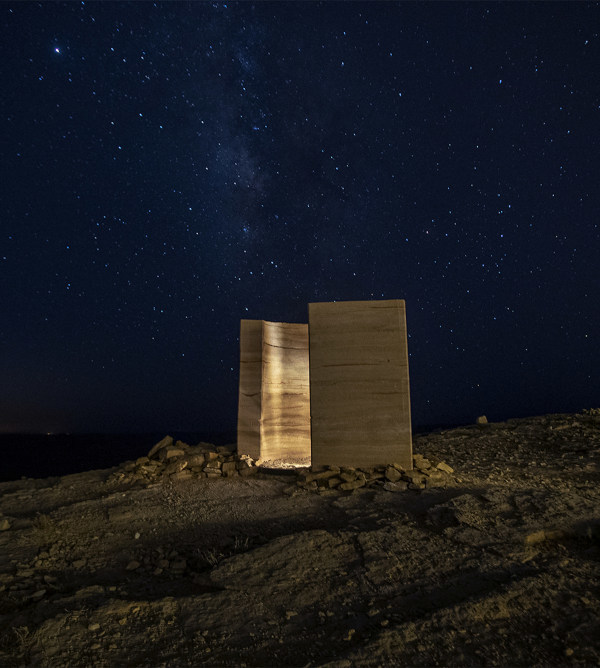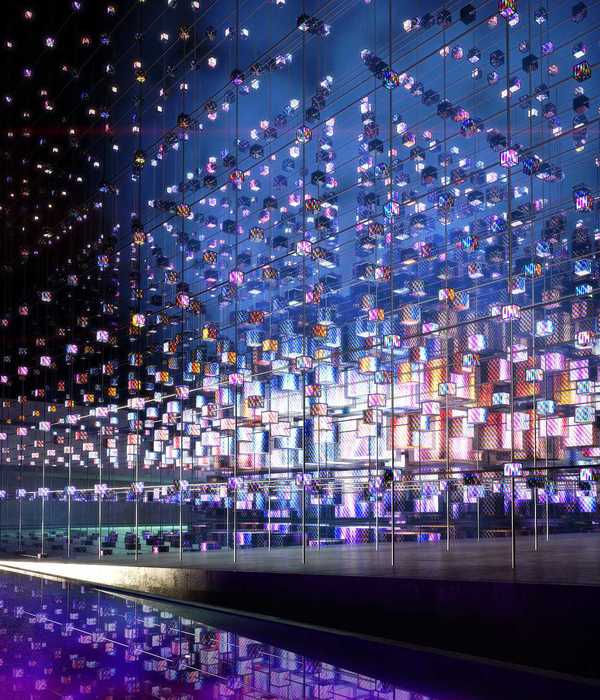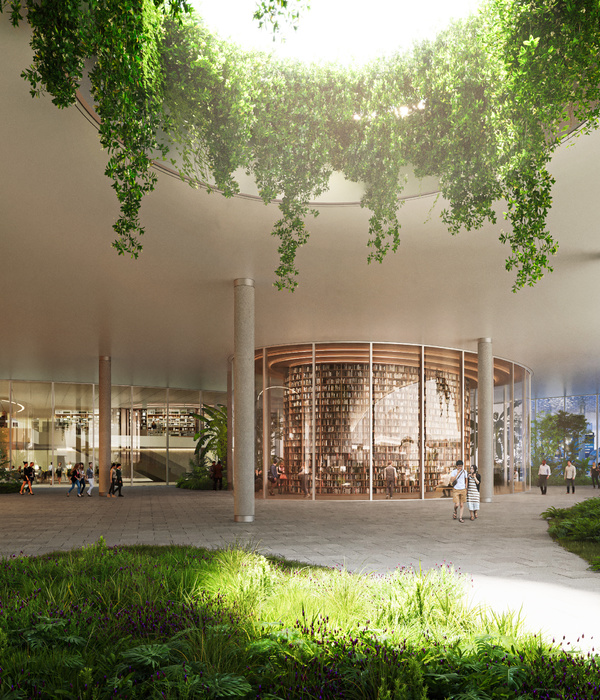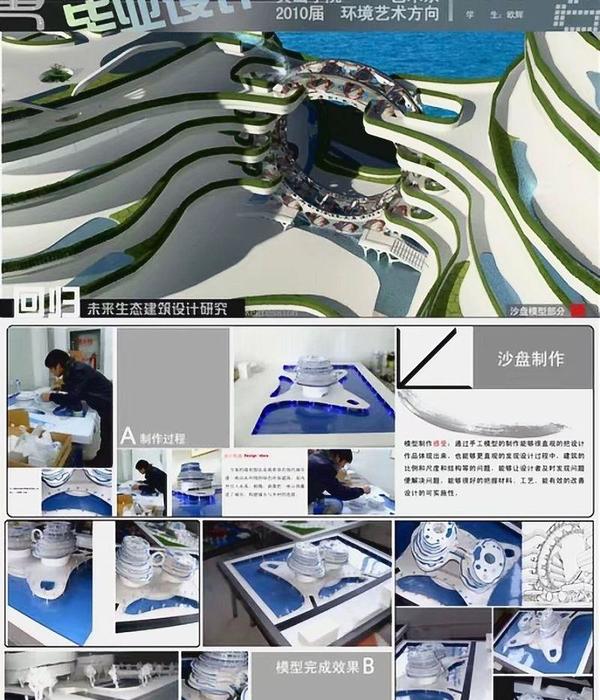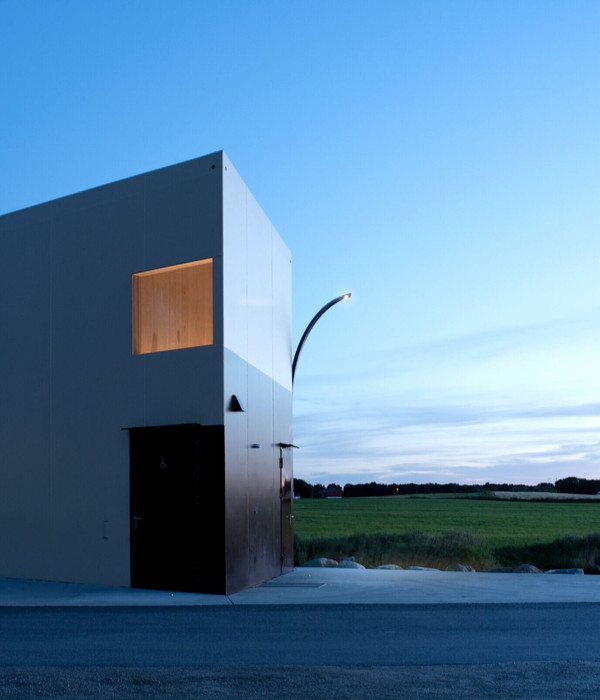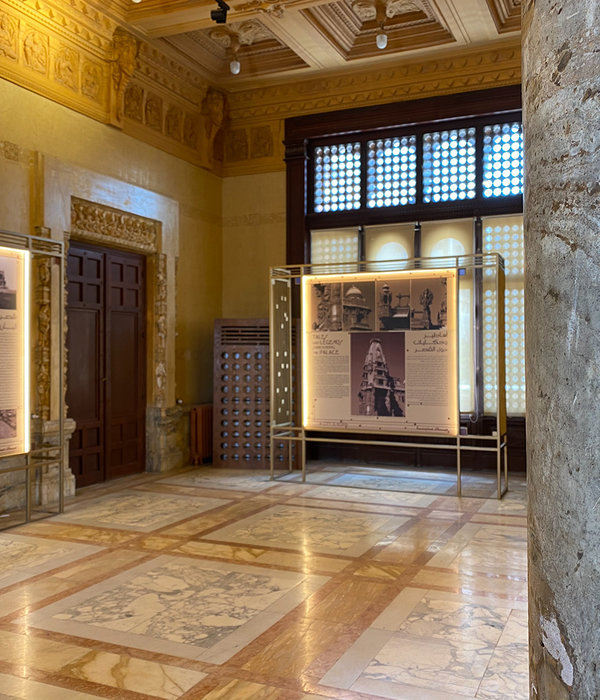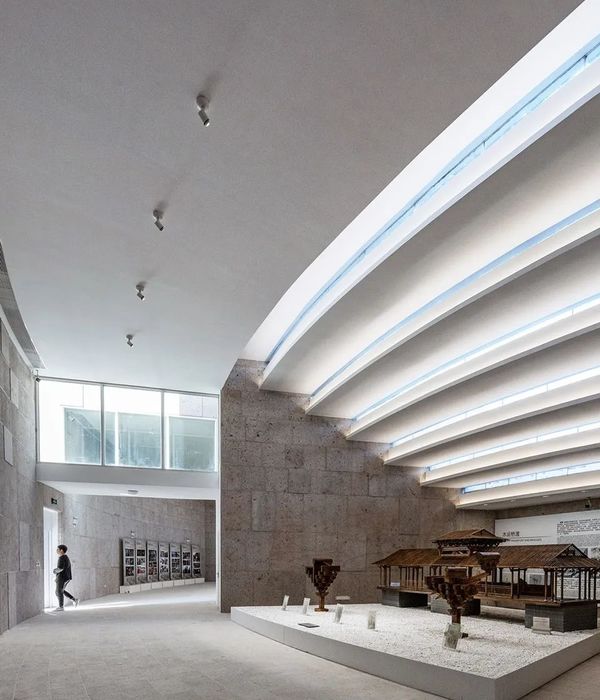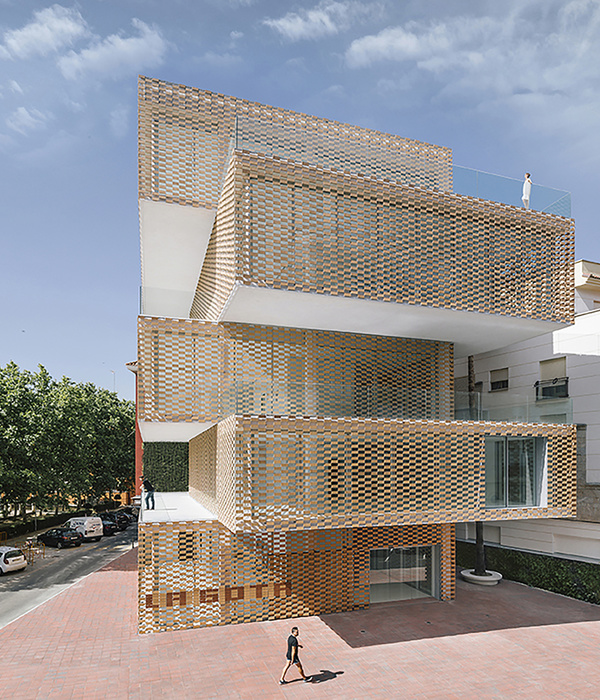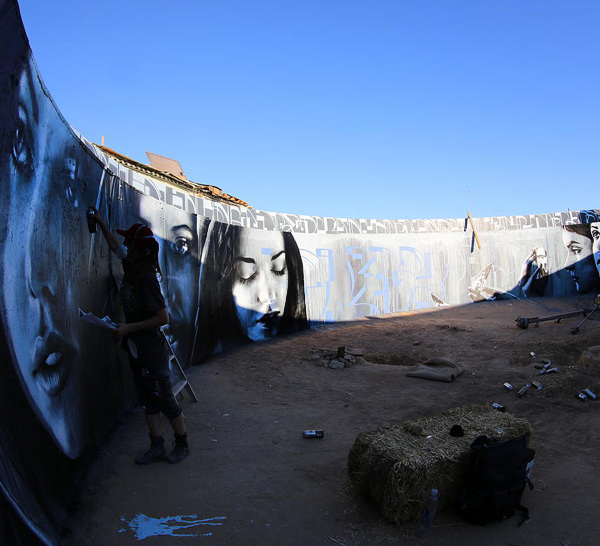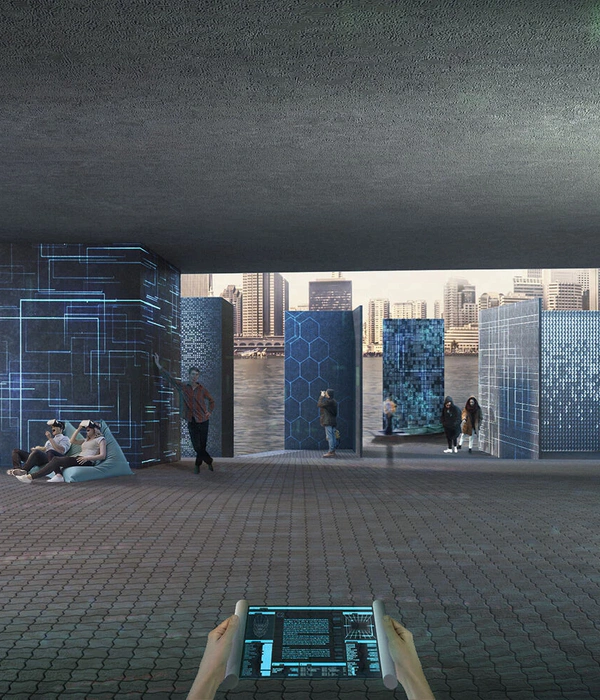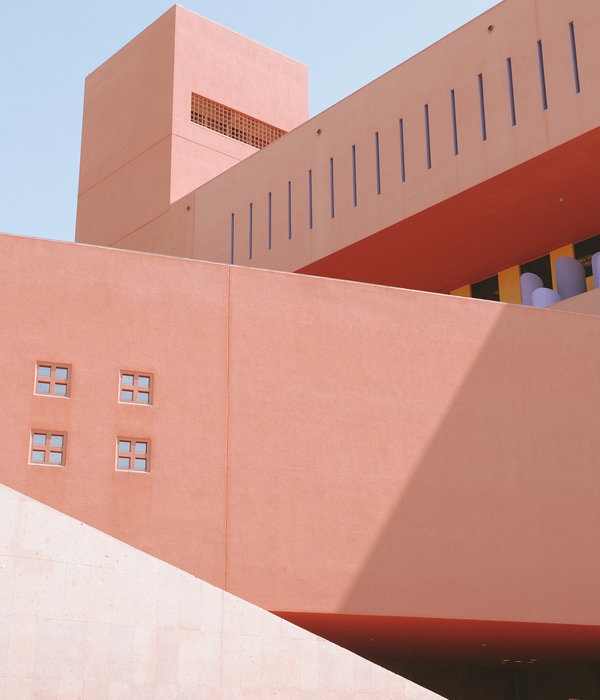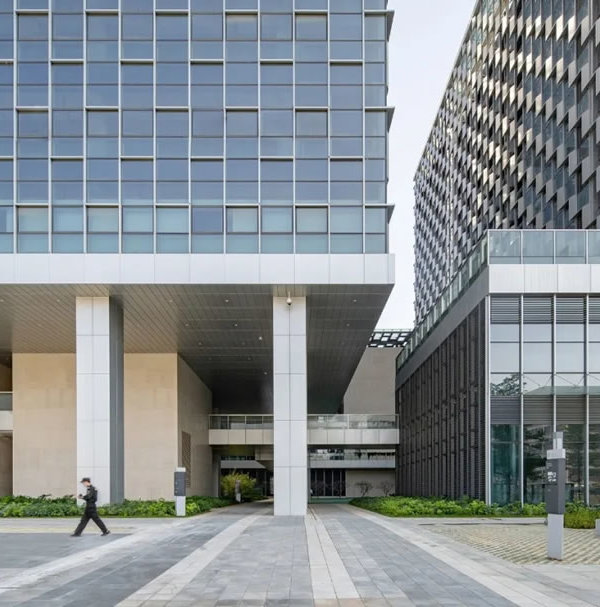2018年末,合造社受重庆懒坝美术馆的委托,为法国国宝级艺术家克里斯蒂安·波尔坦斯基的一件当代艺术作品设计位于重庆武隆仙女山的藏馆。这件作品收集人类的心跳,这个博物馆被命名”心跳博物馆”。
In late 2018, CLAB was commissioned by the Chongqing·LAB Art Museum to design a collection in Chongqing’s Wulong Fairy Mountain for a contemporary art work by French national treasure artist Christian Boltanski. This piece collects the human heartbeat, and this museum was named ” The Heart Pavilion. ”
▼波尔坦斯基站在心跳博物馆的屋顶上,Christian Boltanski stood on the roof of the Heart Pavilion
这个项目的挑战在于建筑师如何在建筑工作中保持建筑学科的独特性和创造力的同时退到艺术家作品的背后去充分表达和呈现艺术家作品。我们的工作从选址到设计始终与波尔坦斯基保持密切的沟通,而建筑方案的构思起点正是来自建筑师对艺术家这一作品的认知和再创作。
The challenge of this project is how architects can maintain the uniqueness and creativity of the architectural discipline while retreating behind the artist’s work to fully express and present the artist’s work. Our work was always in close communication with Christian Boltanski from site selection to design, and the conceptual starting point of the architectural proposal came from the architect’s recognition and re-creation of the artist’s work.
▼心跳博物馆外观,external view ofThe Heart Pavilion
有几个关键的感性认知形成了这次建筑工作的底色:第一个认知,我们希望这个建筑的打开方式是听觉的,而不是视觉的。
第二个认知,建筑的平面形式来自于建筑师在阅读“心跳档案”这一作品时产生的冥想画面:由心跳引发的时空涟漪。
第三个认知,这个建筑的材料会是混凝土。混凝土的力量是下沉的,深入土地的,正如波尔坦斯基对他的创作经验的阐述:从苦难出发,面向死亡。
There are several key perceptual cognitions that form the undertone of this architectural work:The first is that we want the building to be opened in a way that is auditory, not visual.
The second recognition, the flat form of the building, comes from the meditative picture produced by the architect when reading the work “Heartbeat Archive”: the ripples of time and space triggered by the heartbeat.
The third realization is that the material of this building will be concrete. The power of concrete sinks, deep into the land, asChristian Boltanski expounds on his creative experience: from suffering, toward death.
▼心跳博物馆和仙女山和尚岩,The Heart Pavilion and Fairy Nun Mountain monk Rock
博物馆近景鸟瞰,closer aerial view of the pavilion
关于波尔坦斯基和“心跳档案”
Boltanskiand His Heart Archive
克里斯蒂安·波尔坦斯基出生于1944年,二战末期的巴黎,法国著名雕塑家,摄影、艺术家,画家和电影制作人。他的父亲是犹太人,屠杀、失望、命运、记忆一直都是他作品的核心。
1944年,波尔坦斯基出生在从德国占领下解放第12天的巴黎。他的父亲因为犹太人身份曾在二战期间藏身于家中地下室长达数月。战争的阴影伴随着波尔坦斯基的童年以及后来,并促使他用艺术创作的方式回应生命与存在的终极问题。
2008年开始,法国艺术家波尔坦斯基开始在全球收集人的心跳声,并建立心跳档案馆,至今为止,他已经采集完成了12万人的心跳声,并将其存放在日本濑户内丰岛。
Born in 1944 in Paris at the end of World War II, Christian Boltanski was a famous French sculptor, photographer, artist, painter and filmmaker. His father was Jewish, and massacres, disappointments, fate, and memories have always been at the heart of his work.
Christian Boltanski was born in Paris, 12 days after liberation from German occupation in 1944. His father, Jewish, hid in his family’s basement for months during World War II. The shadow of war accompanied Christian Boltanski’s childhood and later, prompting him to respond to the ultimate question of life and existence in the form of artistic creation.
Beginning in 2008, French artist Christian Boltanski began collecting people’s heartbeats around the world and established the heartbeat archive, and so far, he has collected the heartbeats of 120,000 people and stored them on Toshima Island, Setouchi, Japan.
位于濑户内的心跳档案馆,The Heart Archive
心跳档案馆中最重要的空间是馆内的装置“心室”。心室的正中悬挂着一颗白炽灯,白炽灯的频闪和当前播放的某个人的心跳声同步。在黑暗的空间里,伴随着被放大数倍到振聋发聩的心跳声,和频闪的灯光,波尔坦斯基希望用这种方式召唤出人们对生命的感知。
在日本完成心跳档案馆之后,时隔八年,波尔坦斯基接受懒坝美术馆的邀请,在中国重庆武隆设立心跳博物馆继续收集生活在这个世界的人们的心跳。
The most important space in the Heartbeat Archive is the “ventricle” of the museum. In the middle of the ventricle hangs an incandescent lamp, and the strobe of the incandescent lamp is synchronized with the heartbeat of someone currently playing. In the dark space, accompanied by the sound of heartbeats that are magnified several times to deafening, and the strobe of lights, Christian Boltanski hopes to summon people’s perception of life in this way.
Eight years after the completion of the Heart Archive in Japan, Christian Boltanski accepted the invitation of the Chongqing·LAB Art Museum to set up the Heart Pavilion, Wulong, Chongqing, China, to continue to collect the heartbeats of people living in this world.
▼濑户内心跳档案馆中的装置:“心室”,心室中伴随着心跳声闪烁的灯光
the Installation: Heart Room, Flashing Bulb with Heart Beating
▼濑户内心跳档案馆中的搜索区和录心室,访客将自己的心跳收录进入艺术家的心跳档案
Searching Area of the Heart Archive and The Heart Archive, isitors record their own heartbeats in the artist’s heartbeat archives
合造社笔下的“心跳博物馆”
"The Heart Pavilion
Designed by CLAB Architects
心跳博物馆项目是懒坝大地艺术季的一个重要子项。懒坝大地艺术季位于重庆市武隆仙女山的一处台地上。同期建设的项目还包括懒坝美术馆和多个小型建筑。用地背靠垂直落差800米的和尚岩,面向乌江大峡谷。
我们的工作包括了为心跳博物馆选址。出于对艺术家作品的理解,我们选择了一块远离艺术节游览主动线,位于台地边缘的一块用地。建筑基地面朝峡谷,远山云雾尽收眼底。基地和主路之间被一大片树林隔离。在现场选址的时候,“用心跳声音来打开建筑”的想法逐渐形成。在和艺术家沟通后,这块选址最终确定。
The Heart Pavilion project is an important sub-project of the LAB Art Season. The LAB Art Season is located on a terrace in Wulong Fairy Mountain in Chongqing. The projects built at the same time also include the Chongqing·LAB Art Museum and a number of small buildings. The ground is backed by a monk rock with a vertical drop of 800 meters, facing the Wujiang Grand Canyon.
Our work included site selection for The Heart Pavilion. Out of understanding of the artist’s work, we chose a piece of land that was located on the edge of the terrace, away from the festival tour initiative. The construction base faces the canyon, and the distant mountains and clouds can be seen in full view. The base and the main road are separated by a large wood. When choosing a site, the idea of “opening the building with the sound of a heartbeat” gradually took shape. After communicating with the artist, the site was finalized.
▼心跳博物馆选址,site of The Heart Pavilion
位于重庆武隆的心跳博物馆是濑户内心跳档案馆的继任者。它的创作保持了对艺术家作品创作思考的充分尊重,沿袭了艺术家在心跳档案馆中的一系列对功能和布展线路的安排;同时它也不乏创造的闪光点。
艺术家提供的这个布展平面基于濑户内“心跳档案馆”修改,将装置“心室”改变成了圆形。艺术家希望这是一个模糊棱角的空间。心跳博物馆的建筑平面保持了濑户内“心跳档案馆”的布展功能,并以全新的几何关系重新梳理了流线,给出一个更有趣的平面。
The Heart Pavilion in Wulong, Chongqing, is the successor to the Setouchi the Heart Archive. Its creation maintains full respect for the creative thinking of the artist’s work, following a series of arrangements for the function and exhibition route of the artist in the Heartbeat Archive; At the same time, it also has no shortage of creative shining points.
The layout provided by the artist is based on a modification of the Setouchi ” The Heartbeat Archive”, which changes the installation “ventricles” into a circle. The artist wanted it to be a space with blurred edges and corners.The architectural plan of The Heart Pavilion maintains the layout function of “The Heartbeat Archive” in Setouchi, and the streamlines are reorganized with new geometric relationships to give a more interesting plane.
▼艺术家给建筑师提供的功能布展平面和手工概念模型
functional layout plan provided by the artist and the manual conceptual model
▼建筑概念手稿(和艺术家的沟通稿),Architectural concept manuscript (communication with the artist)
建筑平面来自理解艺术家创作思路的一次脑洞:心跳博物馆是一块从心跳引发的时空涟漪中割下的方形切片。最终一组圆形的平面组合形式逐渐清晰。在感性层面,建筑的平面形式来自对心跳声的想象:“由心跳引发的时空涟漪”。在理性层面,这些交叠在一起的圆形房间应功能要求区别出明暗分区,并串接起了一条首尾相接的完整体验流线。
The architectural plan comes from a brain hole in the understanding of the artist’s creative ideas:A Square Cut from the Space-Time Ripple of Heart Beating. The final set of circular plane combinations gradually became clear. On the perceptual level, the flat form of the building comes from the imagination of the sound of a heartbeat: “ripples of time and space triggered by a heartbeat”. On a rational level, these overlapping circular rooms distinguish between light and dark partitions according to functional requirements, and connect a complete experience streamline that connects end to end.
▼平面概念,concept of the plan
和濑户内的心跳档案馆隐藏在海边的树林一样,艺术家希望这个心跳博物馆同样是被“隐藏”起来。建筑的选址位于峡谷的山体的一侧,建筑师将整个建筑沉入山体中。只有穿过一条树林中的弯曲的道路才能进入心跳博物馆。从树林里蜿蜒进入心跳博物馆的道路,道路两侧的树林里发出同步心室的心跳声。
Like The Heart Archive, which is hidden in the woods by the sea, the artist hopes that the Heartbeat Museum will also be “hidden.” The site of the building is located on the side of the mountain in the canyon, and the architects sink the entire building into the mountain.and only through a curved road in the woods can you enter The Heart Pavilion. A road winding from the woods into the Heartbeat Museum, with the sound of synchronized ventricle heartbeats in the woods on both sides of the road.
▼总平面图,site plan
建筑南侧立面由几个完整的圆柱体和两个被切割的圆柱体量组成。被切割后的圆柱体以“室内”的白墙示人。光线和阴影自由的改变建筑的立面表情。
The façade on the south side of the building consists of several complete cylinders and two cylindrical masses that have been cut. The cut cylinder is shown by the white wall “indoors”. Light and shadow freely change the façade expression of the building.
▼切割后的外立面以白墙示人,white wall of the facade cut by the cylinders
▼圆柱体量细部
details of the cylinders
从主道路进入心跳博物馆的路径。建筑沉入山体,被树林遮挡。游览者会首先听到从树林深处发出的心跳声,并沿着声音发出的方向走进心跳博物馆的场地。穿过树林中蜿蜒的路径,体验者从一处楼梯和建筑一起沉入山体。转过建筑的一角,是建筑和山体切割出的远处峡谷的风景。路的尽头是心跳博物馆的入口。在建筑的入口区,是一块厚重的混凝土石门,以回应艺术家对于生命和死亡的创作体验。这是一次感官被不断放大的仪式过程。建筑师希望给参观者呈现的首先是艺术家作品的一个侧面,而不是建筑的外观。希望这个过程既是塑造仪式的过程,也是抛弃形态给与参观者先入为主的视觉形象的过程。
The path from the main road to The Heart Pavilion. The building sank into the mountain and was obscured by woods. Visitors will first hear the heartbeat coming from deep in the woods and walk into the grounds of the Heartbeat Museum in the direction where the sound is emitted. Through winding paths through the woods, the experiencer sinks from a staircase and building into the mountain.Turning around the corner of the building, there is a view of the distant canyon cut out of the building and the mountain. At the end of the road is the entrance to The Heart Pavilion. In the entrance area of the building, there is a heavy concrete stone door that responds to the artist’s creative experience of life and death. It is a ritual process in which the senses are constantly amplified. What the architects wanted to present to the visitor was first and foremost one side of the artist’s work, not the exterior of the building. Hopefully, this process is both a process of shaping the ceremony and a process of abandoning form to give the visitor a preconceived visual image.
▼下沉入山体的楼梯,stairs sinking into the mountain
▼嵌入山体边界的木质扶手,wooden handrails embedded in the mountain boundary
▼远处峡谷的风景,view of the distanced gorge
▼入口,厚重的混凝土门
entrance with a heavy concrete door
进入建筑,来到心跳博物馆的接待室。接待台和文献台同样用混凝土制作而成。接待室一侧的小门通往录音等候区。录音等候区是一处内外交织的空间。光线为这处空间照射出千变万化的图像。建筑圆形平面在此处被感知。录音等候区连接了三个录音室,参观者在录音室记录自己的心跳,并将自己的心跳永久性的保存在艺术家的心跳档案中。
Enter the building and come to the reception room of The Heart Pavilion. The reception desk and the document desk are also made of concrete. A small door on the side of the reception room leads to the recording waiting area.The recording waiting area is a space where the inside and outside are intertwined. Light illuminates this space with ever-changing images. The circular plan of the building is perceived here.The recording waiting area connects three recording studios where visitors record their heartbeats and keep their heartbeats permanently in the artist’s heartbeat archives.
接待区,reception area
▼录音等候区,waiting area for recording
录音室是封闭的圆形房间,供两人对坐。志愿者为访客录制心跳。
the recording studio is an enclosed circular room for two people to sit facing each other. Volunteers record heartbeats for visitors
接待室的另一侧和搜索区相连。搜索区是整个建筑中风景最好的房间,面向峡谷。搜索区供所有参观者使用,参观者在此搜索所有被录入心跳档案里的心跳数据,也包括被录入的参观者自己的心跳数据。参观者将他们搜索到的心跳数据发送至“心室”的装置,并进入“心室“聆听和体验。
The other side of the reception room is connected to the search area. The search area is the most scenic room in the whole building, facing the gorge. The search area is used by all visitors, where visitors search for all the heartbeat data entered into the heartbeat file, including the entered visitor’s own heartbeat data. Visitors send the heartbeat data they searched for to the device in the “ventricles” and enter the “ventricles” to listen and experience.
▼从等待室看向搜索区,perspective from the waiting area to the searching area
▼搜索区,searching area
▼搜索区面向峡谷景观,the search area faces the canyon landscape
等待区面朝另一侧的峡谷,同样是整个建筑中风景最好的区域。整个建筑面积很小,等待区的设置便于控制进入心室的参观人数。通过等待区,经过特殊设计的避光室,则进入了整个建筑最核心的部分,即艺术家的装置:“心室”。
The waiting area faces the other side of the canyon and is also the most scenic area in the whole building. The entire building area is small, and the waiting area is set up to facilitate the control of the number of visitors entering the ventricles. Through the waiting area, the specially designed light-absorbing room enters the very core of the entire building, the artist’s installation: “the ventricle”.
▼从避光室看向等待区。闭光室有两道联动的门,关闭第一扇门后打开第二扇门,保证心室的全黑环境
look out of the light room into the waiting area, the closed light chamber has two linked doors, and after closing the first door, the second door is opened to ensure an all-black environment in the ventricle
心室是一个圆形的空间,室内圆心处悬挂一盏闪烁的白炽灯,灯光闪烁的频率正是同时播放的心跳频率。上图为波尔坦斯基在上海当代艺术博物馆创作的心跳装置,播放的正是波尔坦斯基自己的心跳。
The ventricle is a circular space, and a flickering incandescent lamp hangs at the center of the room, and the frequency of the light flickering is the frequency of the heartbeat that plays at the same time. Above, Christian Boltanski’s heartbeat device at the Museum of Contemporary Art in Shanghai shows Christian Boltanski’s own heartbeat.
▼心跳博物馆的心室,Heart Room of the Heart Pavilion
“心跳博物馆”的装置心室由房间正中央悬挂的频闪白炽灯和房间周围由黑色镜面亚克力板拼装的墙面组成。和丰岛“心跳档案馆”中方形的心室不同,“心跳博物馆”中的圆形平面提供了一种独特的空间体验:所有黑色镜面均指向房间的圆心。参观者在房间圆心处,伴随这心跳声和频闪灯光的是出现在黑色镜面中无数个自己的倒影。这些倒影同样跟随着心跳的节奏起伏涨落。
The installation chamber of the ” The Heart Pavilion ” consists of a strobe incandescent lamp hanging in the center of the room and a wall surrounded by black mirror acrylic panels. Unlike the square ventricles in the Toshima Heartbeat Archive, the circular plane in The Heart Pavilion offers a unique spatial experience: all the black mirrors point to the center of the room. Visitors are in the center of the room, accompanied by the sound of this heartbeat and strobe lights are countless reflections of themselves appearing in the black mirror. These reflections also follow the rhythm of the heartbeat.
▼心室剖面,section of the Heart Room
关于建造和开馆
About the construction and opening of the museum
心跳博物馆于2019年4月开工建造,这个小建筑也是合造社2019年开工的第一个项目。截至2019年6月,心跳博物馆已经完成建筑主体建造,于2019.08.03同懒坝国际大地艺术节开幕日一同开馆。
Construction of The Heart Pavilion began in April 2019, and this small building is also the first project of the Company to start construction in 2019. As of June 2019, The Heart Pavilion has completed the construction of the main building and opened on 2019.08.03 together with the opening day of the LAB International Land Art Festival.
"死亡不是生命的终点,遗忘才是。那些证明活着的心跳声,应该被纪录、储存、放大,被心爱的人聆听"。心跳博物馆,将在无限时间长河中的一段有限的时间里,陪伴大家记录、储存、放大、聆听生命。
"Death is not the end of life, forgetting is." The sound of a heartbeat that proves to be alive should be recorded, stored, amplified, and heard by loved ones." The Heartbeat Museum will accompany everyone to record, store, enlarge and listen to life for a limited period of time in an infinite river of time.
▼合造社设计的“心跳博物馆”平面,plan of The Heart Paviliondesigned by CLAB
▼剖透视图,sectional perspective
项目名称:心跳博物馆
设计方:合造社建筑设计事务所
设计时间:2018.12-2019.05
建成时间:2019.06
主持建筑师:徐浪
项目主管/项目建筑师:徐浪
建筑设计团队:徐浪,陈东旭,秦晓彦
项目地址:重庆市武隆区仙女山
建筑面积:195㎡
摄影版权:合造社,重庆懒坝美术馆
结构设计:冉晋滔
客户:重庆懒坝美术馆
项目类型:文化建筑
Project Name: The Heart Pavilion
Design: CLABDesign Time:2018.12-2019.05Construction Time: 2019.06
Main Architect: Xu Lang
Project Director/Project Architect: Xu Lang
Architectural Design Team: Xu Lang,Chen Dongxu,Qin Xiaoyan
Project Location: Xiannu Mountain, Wulong District, Chongqing
Gross Built Area: 195 square meters
Photo Credits: CLAB,Chongqing·LAB Art Museum
Architectonics: Ran Jintao
Clients: Chongqing·LAB Art Museum,Program: Cultural Architecture
{{item.text_origin}}

